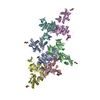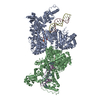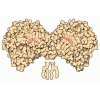[English] 日本語
 Yorodumi
Yorodumi- EMDB-20524: Cryo-EM structure of full-length IGF1R-IGF1 complex. Only the ext... -
+ Open data
Open data
- Basic information
Basic information
| Entry | Database: EMDB / ID: EMD-20524 | |||||||||
|---|---|---|---|---|---|---|---|---|---|---|
| Title | Cryo-EM structure of full-length IGF1R-IGF1 complex. Only the extracellular region of the complex is resolved. | |||||||||
 Map data Map data | full-length IGF1R-IGF1 complex | |||||||||
 Sample Sample |
| |||||||||
 Keywords Keywords | IGF1R / IGF1 / SIGNALING PROTEIN-HORMONE complex | |||||||||
| Function / homology |  Function and homology information Function and homology informationSignaling by Type 1 Insulin-like Growth Factor 1 Receptor (IGF1R) / IRS-related events triggered by IGF1R / SHC-related events triggered by IGF1R / mitotic nuclear division / glycolate metabolic process / muscle hypertrophy / negative regulation of oocyte development / positive regulation of trophectodermal cell proliferation / insulin-like growth factor binding protein complex / insulin-like growth factor ternary complex ...Signaling by Type 1 Insulin-like Growth Factor 1 Receptor (IGF1R) / IRS-related events triggered by IGF1R / SHC-related events triggered by IGF1R / mitotic nuclear division / glycolate metabolic process / muscle hypertrophy / negative regulation of oocyte development / positive regulation of trophectodermal cell proliferation / insulin-like growth factor binding protein complex / insulin-like growth factor ternary complex / proteoglycan biosynthetic process / negative regulation of cholangiocyte apoptotic process / positive regulation of glycoprotein biosynthetic process / myotube cell development / Extra-nuclear estrogen signaling / insulin-like growth factor receptor activity / positive regulation of steroid hormone biosynthetic process / skeletal muscle satellite cell maintenance involved in skeletal muscle regeneration / negative regulation of neuroinflammatory response / Signaling by Type 1 Insulin-like Growth Factor 1 Receptor (IGF1R) / negative regulation of vascular associated smooth muscle cell apoptotic process / bone mineralization involved in bone maturation / insulin-like growth factor binding / IRS-related events triggered by IGF1R / positive regulation of cell growth involved in cardiac muscle cell development / exocytic vesicle / negative regulation of muscle cell apoptotic process / positive regulation of meiotic cell cycle / positive regulation of transcription regulatory region DNA binding / positive regulation of DNA metabolic process / mammary gland development / cell activation / positive regulation of developmental growth / positive regulation of calcineurin-NFAT signaling cascade / male sex determination / exocrine pancreas development / prostate gland epithelium morphogenesis / insulin receptor complex / insulin receptor activity / negative regulation of hepatocyte apoptotic process / alphav-beta3 integrin-IGF-1-IGF1R complex / positive regulation of Ras protein signal transduction / positive regulation of protein-containing complex disassembly / myoblast differentiation / positive regulation of insulin-like growth factor receptor signaling pathway / myoblast proliferation / muscle organ development / dendritic spine maintenance / negative regulation of interleukin-1 beta production / response to L-glutamate / adrenal gland development / cellular response to insulin-like growth factor stimulus / positive regulation of DNA binding / establishment of cell polarity / postsynaptic modulation of chemical synaptic transmission / negative regulation of release of cytochrome c from mitochondria / positive regulation of cytokinesis / positive regulation of cardiac muscle hypertrophy / positive regulation of axon regeneration / positive regulation of smooth muscle cell migration / positive regulation of activated T cell proliferation / positive regulation of osteoblast proliferation / negative regulation of amyloid-beta formation / negative regulation of smooth muscle cell apoptotic process / regulation of JNK cascade / negative regulation of tumor necrosis factor production / insulin receptor substrate binding / negative regulation of phosphatidylinositol 3-kinase/protein kinase B signal transduction / epithelial to mesenchymal transition / positive regulation of glycogen biosynthetic process / G-protein alpha-subunit binding / Synthesis, secretion, and deacylation of Ghrelin / epidermis development / estrous cycle / negative regulation of MAPK cascade / SHC-related events triggered by IGF1R / positive regulation of osteoblast differentiation / phosphatidylinositol 3-kinase binding / positive regulation of tyrosine phosphorylation of STAT protein / cellular response to transforming growth factor beta stimulus / positive regulation of vascular associated smooth muscle cell proliferation / insulin-like growth factor receptor binding / T-tubule / activation of protein kinase B activity / phosphatidylinositol 3-kinase/protein kinase B signal transduction / positive regulation of glycolytic process / positive regulation of mitotic nuclear division / axonogenesis / positive regulation of epithelial cell proliferation / cerebellum development / insulin-like growth factor receptor signaling pathway / platelet alpha granule lumen / skeletal system development / positive regulation of D-glucose import / positive regulation of protein secretion / negative regulation of extrinsic apoptotic signaling pathway / animal organ morphogenesis / cellular response to glucose stimulus / positive regulation of smooth muscle cell proliferation / insulin receptor binding Similarity search - Function | |||||||||
| Biological species |   Homo sapiens (human) Homo sapiens (human) | |||||||||
| Method | single particle reconstruction / cryo EM / Resolution: 4.3 Å | |||||||||
 Authors Authors | Li J / Choi E | |||||||||
 Citation Citation |  Journal: Nat Commun / Year: 2019 Journal: Nat Commun / Year: 2019Title: Structural basis of the activation of type 1 insulin-like growth factor receptor. Authors: Jie Li / Eunhee Choi / Hongtao Yu / Xiao-Chen Bai /  Abstract: Type 1 insulin-like growth factor receptor (IGF1R) is a receptor tyrosine kinase that regulates cell growth and proliferation, and can be activated by IGF1, IGF2, and insulin. Here, we report the ...Type 1 insulin-like growth factor receptor (IGF1R) is a receptor tyrosine kinase that regulates cell growth and proliferation, and can be activated by IGF1, IGF2, and insulin. Here, we report the cryo-EM structure of full-length IGF1R-IGF1 complex in the active state. This structure reveals that only one IGF1 molecule binds the Γ-shaped asymmetric IGF1R dimer. The IGF1-binding site is formed by the L1 and CR domains of one IGF1R protomer and the α-CT and FnIII-1 domains of the other. The liganded α-CT forms a rigid beam-like structure with the unliganded α-CT, which hinders the conformational change of the unliganded α-CT required for binding of a second IGF1 molecule. We further identify an L1-FnIII-2 interaction that mediates the dimerization of membrane-proximal domains of IGF1R. This interaction is required for optimal receptor activation. Our study identifies a source of the negative cooperativity in IGF1 binding to IGF1R and reveals the structural basis of IGF1R activation. | |||||||||
| History |
|
- Structure visualization
Structure visualization
| Movie |
 Movie viewer Movie viewer |
|---|---|
| Structure viewer | EM map:  SurfView SurfView Molmil Molmil Jmol/JSmol Jmol/JSmol |
| Supplemental images |
- Downloads & links
Downloads & links
-EMDB archive
| Map data |  emd_20524.map.gz emd_20524.map.gz | 77.7 MB |  EMDB map data format EMDB map data format | |
|---|---|---|---|---|
| Header (meta data) |  emd-20524-v30.xml emd-20524-v30.xml emd-20524.xml emd-20524.xml | 14 KB 14 KB | Display Display |  EMDB header EMDB header |
| Images |  emd_20524.png emd_20524.png | 178.7 KB | ||
| Filedesc metadata |  emd-20524.cif.gz emd-20524.cif.gz | 6.1 KB | ||
| Archive directory |  http://ftp.pdbj.org/pub/emdb/structures/EMD-20524 http://ftp.pdbj.org/pub/emdb/structures/EMD-20524 ftp://ftp.pdbj.org/pub/emdb/structures/EMD-20524 ftp://ftp.pdbj.org/pub/emdb/structures/EMD-20524 | HTTPS FTP |
-Validation report
| Summary document |  emd_20524_validation.pdf.gz emd_20524_validation.pdf.gz | 519.2 KB | Display |  EMDB validaton report EMDB validaton report |
|---|---|---|---|---|
| Full document |  emd_20524_full_validation.pdf.gz emd_20524_full_validation.pdf.gz | 518.8 KB | Display | |
| Data in XML |  emd_20524_validation.xml.gz emd_20524_validation.xml.gz | 6 KB | Display | |
| Data in CIF |  emd_20524_validation.cif.gz emd_20524_validation.cif.gz | 6.9 KB | Display | |
| Arichive directory |  https://ftp.pdbj.org/pub/emdb/validation_reports/EMD-20524 https://ftp.pdbj.org/pub/emdb/validation_reports/EMD-20524 ftp://ftp.pdbj.org/pub/emdb/validation_reports/EMD-20524 ftp://ftp.pdbj.org/pub/emdb/validation_reports/EMD-20524 | HTTPS FTP |
-Related structure data
| Related structure data |  6pyhMC M: atomic model generated by this map C: citing same article ( |
|---|---|
| Similar structure data |
- Links
Links
| EMDB pages |  EMDB (EBI/PDBe) / EMDB (EBI/PDBe) /  EMDataResource EMDataResource |
|---|---|
| Related items in Molecule of the Month |
- Map
Map
| File |  Download / File: emd_20524.map.gz / Format: CCP4 / Size: 83.7 MB / Type: IMAGE STORED AS FLOATING POINT NUMBER (4 BYTES) Download / File: emd_20524.map.gz / Format: CCP4 / Size: 83.7 MB / Type: IMAGE STORED AS FLOATING POINT NUMBER (4 BYTES) | ||||||||||||||||||||||||||||||||||||||||||||||||||||||||||||
|---|---|---|---|---|---|---|---|---|---|---|---|---|---|---|---|---|---|---|---|---|---|---|---|---|---|---|---|---|---|---|---|---|---|---|---|---|---|---|---|---|---|---|---|---|---|---|---|---|---|---|---|---|---|---|---|---|---|---|---|---|---|
| Annotation | full-length IGF1R-IGF1 complex | ||||||||||||||||||||||||||||||||||||||||||||||||||||||||||||
| Projections & slices | Image control
Images are generated by Spider. | ||||||||||||||||||||||||||||||||||||||||||||||||||||||||||||
| Voxel size | X=Y=Z: 1.07 Å | ||||||||||||||||||||||||||||||||||||||||||||||||||||||||||||
| Density |
| ||||||||||||||||||||||||||||||||||||||||||||||||||||||||||||
| Symmetry | Space group: 1 | ||||||||||||||||||||||||||||||||||||||||||||||||||||||||||||
| Details | EMDB XML:
CCP4 map header:
| ||||||||||||||||||||||||||||||||||||||||||||||||||||||||||||
-Supplemental data
- Sample components
Sample components
-Entire : Full-length MmIGF1R-HsIGF1 complex
| Entire | Name: Full-length MmIGF1R-HsIGF1 complex |
|---|---|
| Components |
|
-Supramolecule #1: Full-length MmIGF1R-HsIGF1 complex
| Supramolecule | Name: Full-length MmIGF1R-HsIGF1 complex / type: complex / ID: 1 / Parent: 0 / Macromolecule list: all |
|---|---|
| Molecular weight | Theoretical: 336 KDa |
-Supramolecule #2: MmIGF1R
| Supramolecule | Name: MmIGF1R / type: complex / ID: 2 / Parent: 1 / Macromolecule list: #1 |
|---|---|
| Source (natural) | Organism:  |
-Supramolecule #3: HsIGF1
| Supramolecule | Name: HsIGF1 / type: complex / ID: 3 / Parent: 1 / Macromolecule list: #2 |
|---|---|
| Source (natural) | Organism:  Homo sapiens (human) Homo sapiens (human) |
-Macromolecule #1: Insulin-like growth factor 1 receptor
| Macromolecule | Name: Insulin-like growth factor 1 receptor / type: protein_or_peptide / ID: 1 / Number of copies: 2 / Enantiomer: LEVO / EC number: receptor protein-tyrosine kinase |
|---|---|
| Source (natural) | Organism:  |
| Molecular weight | Theoretical: 145.279906 KDa |
| Recombinant expression | Organism:  Homo sapiens (human) Homo sapiens (human) |
| Sequence | String: EICGPGIDIR NDYQQLKRLE NCTVIEGFLH ILLISKAEDY RSYRFPKLTV ITEYLLLFRV AGLESLGDLF PNLTVIRGWK LFYNYALVI FEMTNLKDIG LYNLRNITRG AIRIEKNADL CYLSTIDWSL ILDAVSNNYI VGNKPPKECG DLCPGTLEEK P MCEKTTIN ...String: EICGPGIDIR NDYQQLKRLE NCTVIEGFLH ILLISKAEDY RSYRFPKLTV ITEYLLLFRV AGLESLGDLF PNLTVIRGWK LFYNYALVI FEMTNLKDIG LYNLRNITRG AIRIEKNADL CYLSTIDWSL ILDAVSNNYI VGNKPPKECG DLCPGTLEEK P MCEKTTIN NEYNYRCWTT NRCQKMCPSV CGKRACTENN ECCHPECLGS CHTPDDNTTC VACRHYYYKG VCVPACPPGT YR FEGWRCV DRDFCANIPN AESSDSDGFV IHDDECMQEC PSGFIRNSTQ SMYCIPCEGP CPKVCGDEEK KTKTIDSVTS AQM LQGCTI LKGNLLINIR RGNNIASELE NFMGLIEVVT GYVKIRHSHA LVSLSFLKNL RLILGEEQLE GNYSFYVLDN QNLQ QLWDW NHRNLTVRSG KMYFAFNPKL CVSEIYRMEE VTGTKGRQSK GDINTRNNGE RASCESDVLR FTSTTTWKNR IIITW HRYR PPDYRDLISF TVYYKEAPFK NVTEYDGQDA CGSNSWNMVD VDLPPNKEGE PGILLHGLKP WTQYAVYVKA VTLTMV END HIRGAKSEIL YIRTNASVPS IPLDVLSASN SSSQLIVKWN PPTLPNGNLS YYIVRWQRQP QDGYLYRHNY CSKDKIP IR KYADGTIDVE EVTENPKTEV CGGDKGPCCA CPKTEAEKQA EKEEAEYRKV FENFLHNSIF VPRPERRRRD VMQVANTT M SSRSRNTTVA DTYNITDPEE FETEYPFFES RVDNKERTVI SNLRPFTLYR IDIHSCNHEA EKLGCSASNF VFARTMPAE GADDIPGPVT WEPRPENSIF LKWPEPENPN GLILMYEIKY GSQVEDQREC VSRQEYRKYG GAKLNRLNPG NYTARIQATS LSGNGSWTD PVFFYVPAKT TYENFMHLII ALPVAILLIV GGLVIMLYVF HRKRNNSRLG NGVLYASVNP EAFSAADVYV P DEWEVARE KITMNRELGQ GSFGMVYEGV AKGVVKDEPE TRVAIKTVNE AASMRERIEF LNEASVMKEF NCHHVVRLLG VV SQGQPTL VIMELMTRGD LKSYLRSLRP EVEQNNLVLI PPSLSKMIQM AGEIADGMAY LNANKFVHRN LAARNCMVAE DFT VKIGDF GMTRDIYETD YYRKGGKGLL PVRWMSPESL KDGVFTTHSD VWSFGVVLWE IATLAEQPYQ GLSNEQVLRF VMEG GLLDK PDNCPDMLFE LMRMCWQYNP KMRPSFLEII GSIKDEMEPS FQEVSFYYSE ENKPPEPGTS SGLEVLFQ UniProtKB: Insulin-like growth factor 1 receptor |
-Macromolecule #2: Insulin-like growth factor I
| Macromolecule | Name: Insulin-like growth factor I / type: protein_or_peptide / ID: 2 / Number of copies: 1 / Enantiomer: LEVO |
|---|---|
| Source (natural) | Organism:  Homo sapiens (human) Homo sapiens (human) |
| Molecular weight | Theoretical: 7.663752 KDa |
| Recombinant expression | Organism:  |
| Sequence | String: GPETLCGAEL VDALQFVCGD RGFYFNKPTG YGSSSRRAPQ TGIVDECCFR SCDLRRLEMY CAPLKPAKSA UniProtKB: Insulin-like growth factor I |
-Experimental details
-Structure determination
| Method | cryo EM |
|---|---|
 Processing Processing | single particle reconstruction |
| Aggregation state | particle |
- Sample preparation
Sample preparation
| Concentration | 7 mg/mL |
|---|---|
| Buffer | pH: 7.5 |
| Grid | Details: unspecified |
| Vitrification | Cryogen name: ETHANE / Chamber humidity: 100 % / Instrument: FEI VITROBOT MARK IV |
- Electron microscopy
Electron microscopy
| Microscope | FEI TITAN KRIOS |
|---|---|
| Image recording | Film or detector model: GATAN K2 IS (4k x 4k) / Average exposure time: 15.0 sec. / Average electron dose: 50.0 e/Å2 |
| Electron beam | Acceleration voltage: 300 kV / Electron source:  FIELD EMISSION GUN FIELD EMISSION GUN |
| Electron optics | C2 aperture diameter: 70.0 µm / Illumination mode: FLOOD BEAM / Imaging mode: BRIGHT FIELD / Cs: 2.7 mm |
| Sample stage | Specimen holder model: FEI TITAN KRIOS AUTOGRID HOLDER / Cooling holder cryogen: NITROGEN |
| Experimental equipment |  Model: Titan Krios / Image courtesy: FEI Company |
+ Image processing
Image processing
-Atomic model buiding 1
| Refinement | Space: REAL / Protocol: FLEXIBLE FIT |
|---|---|
| Output model |  PDB-6pyh: |
 Movie
Movie Controller
Controller

























 Z (Sec.)
Z (Sec.) Y (Row.)
Y (Row.) X (Col.)
X (Col.)





















